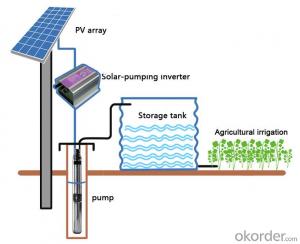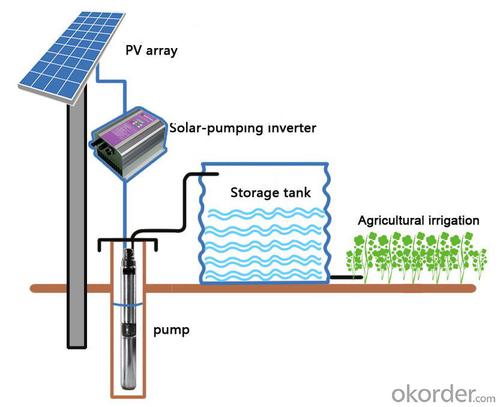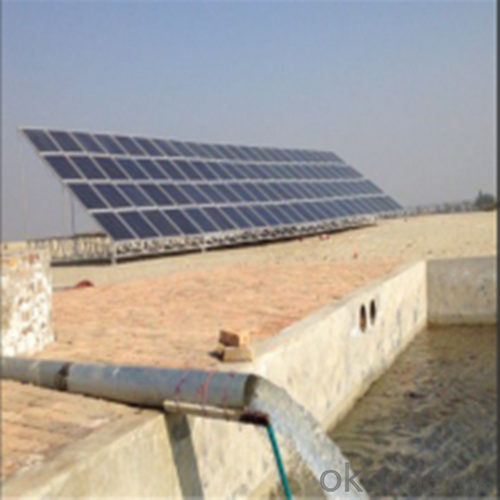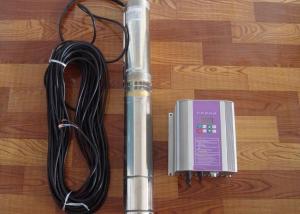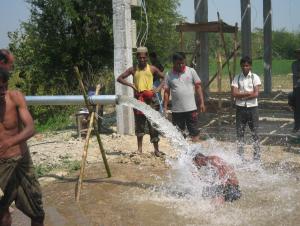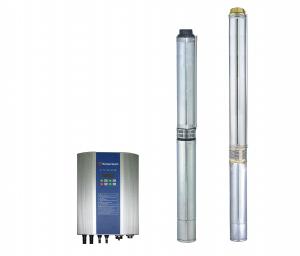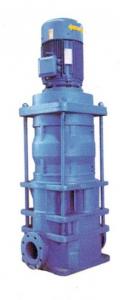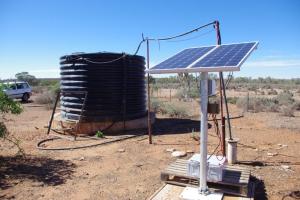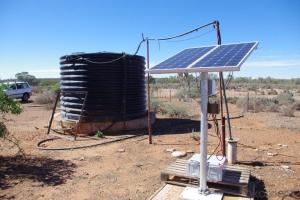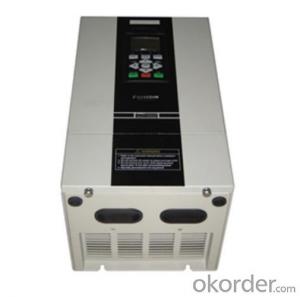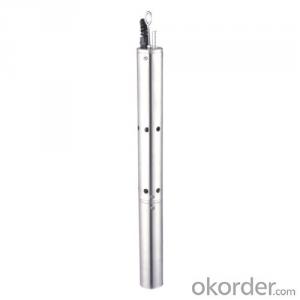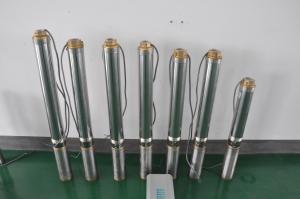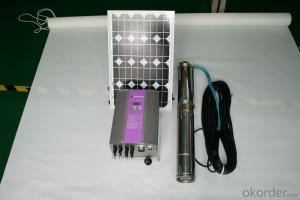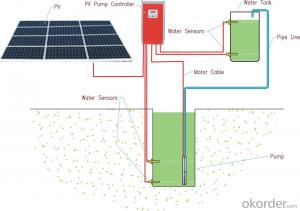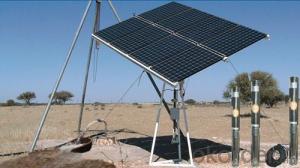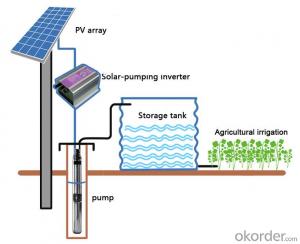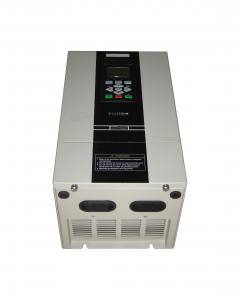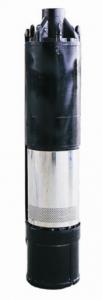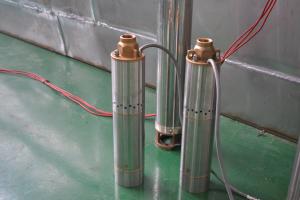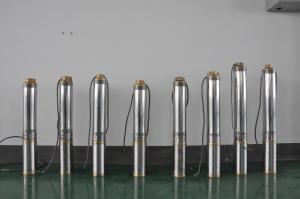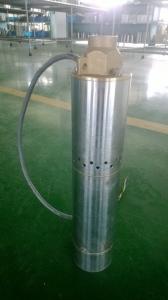10hp Solar Pump - Solar Irrigation Pump with Solar Panel Water Pumps
- Loading Port:
- Shanghai
- Payment Terms:
- TT OR LC
- Min Order Qty:
- 1 set
- Supply Capability:
- 1000 set/month
OKorder Service Pledge
OKorder Financial Service
You Might Also Like
Solar Irrigation Pump Solar Panel Water Pumps
DC solar water pumping system consists of the motor, pump, controller, solar array and some other accessories, such as water level sensor, float switch, etc. Considered that storing water is more efficient than storing electricity, the system is designed to directly drive the pump without battery which can reduce the construction and operating cost and routine maintenance effectively.The PV array consists of multiple solar panels connected in series/parallel, which can supply the whole system as power source by converting the absorbed solar radiation energy to the electrical energy. The pump driven by a brushless DC permanent magnet motor draws water from deep-well or river. The pumped water is then fed into reservoir or water tank, or connected to the irrigation system or fountain system directly.
Advanced Technology
Applications Innovation
The efficiency of DC brushless permanent magnet motor has been increased up to 25% in comparison with traditional asynchronous motor.
Technology Innovation
Stator and rotor are sealed by environment friendly casting resin.Motor insulation resistance can be hold higher than 300MΩfor more than 10 years, which consumedly increased the security and reliability of the submersible motor.
Structure Innovation
Casting resign technology processed stator and rotor as well as the water lubricated bearing make the submersible pump environment friendly.
Feature
High Efficiency & High Reliability
DC Brushless Permanent Magnet Motor
Minimum Maintenance, long Service Life
Environment Friendly Materials, Lubricated Without Oil
Application
Village or Family Water Supply
Animal Drinking Water & Livestock Watering
Garden/Courtyard Irrigation
Swimming Pool
Water Supply for Bivouac or Camping Car
Water Supply for Remote Area
Automatic Control
Operate Automatically, No Need Watching
Maximum Power Point Tracking (MPPT)
Dry-run Protection
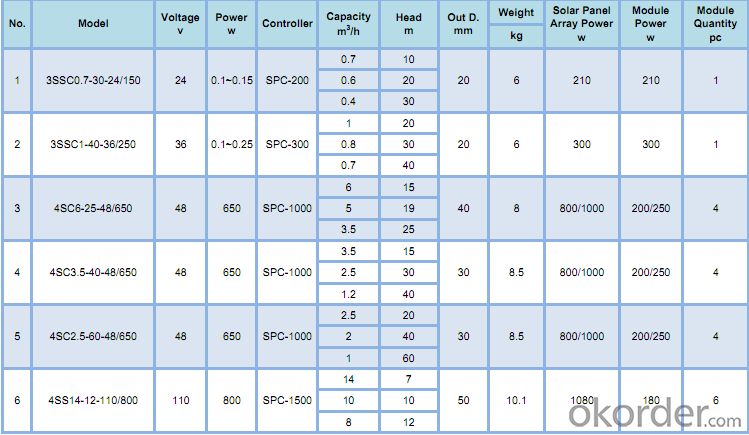
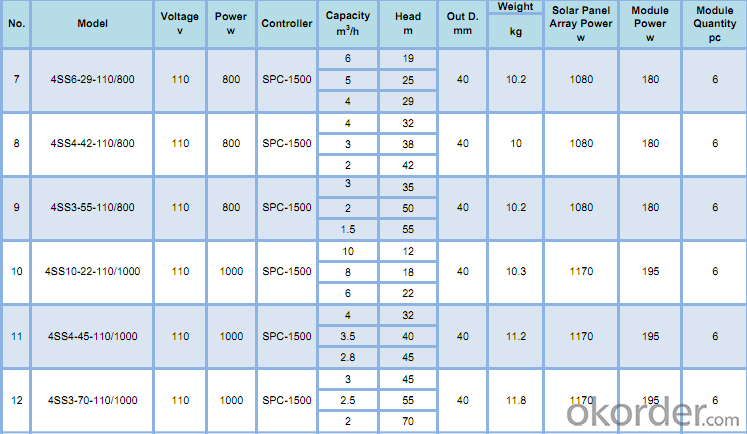
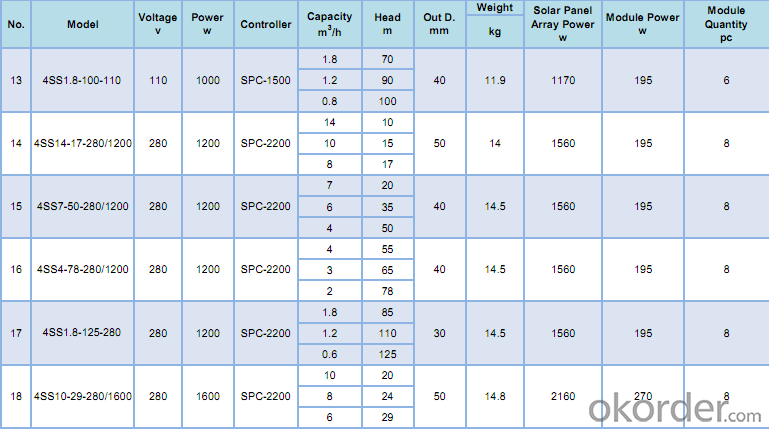
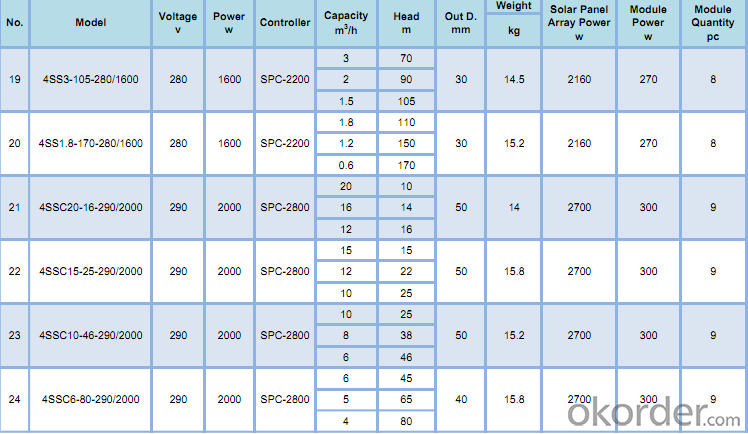


- Q: Can a solar pump be used for fountain or waterfall features?
- Indeed, fountain or waterfall features can make use of a solar pump. These pumps are specifically devised to run on solar energy, eliminating the need for electricity from the grid. This renders them a perfect option for outdoor water features like fountains or waterfalls, where accessing electricity can prove arduous or costly. Solar pumps typically boast effortless installation and operation, ensuring a steady water flow that gives rise to stunning and calming water exhibitions. Furthermore, opting for a solar pump for a fountain or waterfall exemplifies environmental consciousness as it harnesses renewable energy and diminishes dependence on conventional electricity sources.
- Q: Can solar pumps be integrated with existing water filtration systems?
- Yes, solar pumps can be integrated with existing water filtration systems. Solar pumps are versatile and can easily be connected to the existing infrastructure of water filtration systems, allowing for a more sustainable and efficient operation. The solar-powered pumps can provide a reliable source of energy to power the filtration system, reducing dependence on traditional electricity sources and enabling water filtration in remote or off-grid locations.
- Q: Can a solar pump be used for water supply in national parks or wildlife reserves?
- Yes, a solar pump can definitely be used for water supply in national parks or wildlife reserves. Solar pumps are an excellent and sustainable alternative to traditional pumps that require electricity or fuel. They harness the power of the sun to pump water from sources such as rivers, lakes, or wells and supply it to various locations within the parks or reserves. One of the main advantages of using solar pumps in these areas is their environmental friendliness. National parks and wildlife reserves are dedicated to preserving and protecting the natural ecosystem, so using solar pumps aligns perfectly with their goals. Solar pumps produce clean energy, reducing greenhouse gas emissions and minimizing the ecological impact on the surrounding environment. Furthermore, solar pumps are highly reliable and require minimal maintenance. They operate silently and efficiently, ensuring a consistent water supply for various purposes within the parks or reserves. This can include providing water for drinking, irrigation of plants, or even for wildlife habitats and watering holes. In remote areas, where access to electricity may be limited or non-existent, solar pumps are particularly beneficial. They can be installed in off-grid locations, eliminating the need for extensive electrical infrastructure and reducing costs associated with traditional pumps. Additionally, solar pumps can be easily integrated with other renewable energy sources, such as solar panels or wind turbines, to create a sustainable and self-sufficient water supply system. Overall, solar pumps are a viable and practical option for water supply in national parks or wildlife reserves. They offer numerous benefits, including environmental sustainability, reliability, and cost-effectiveness. By harnessing the power of the sun, these pumps can contribute to the conservation efforts of these protected areas while ensuring a reliable water supply for both humans and wildlife.
- Q: How does a solar pump help in reducing carbon emissions?
- A solar pump helps in reducing carbon emissions by eliminating the need for conventional electricity sources, such as diesel or coal-powered generators. By utilizing solar energy, the pump operates entirely on renewable power, thus reducing greenhouse gas emissions associated with fossil fuel consumption. This sustainable alternative contributes to a cleaner environment and helps mitigate climate change.
- Q: How does a solar pump handle water with high levels of sand or other abrasives?
- A solar pump with high levels of sand or other abrasives typically has a built-in filtration system to prevent clogging. This system helps separate the sand or other particles from the water, ensuring smooth operation and reducing the risk of damage to the pump.
- Q: Are solar pumps suitable for areas prone to flooding?
- Yes, solar pumps are suitable for areas prone to flooding. Since they operate on solar power, they do not depend on electricity grids and can continue to function even during floods. They are also typically designed to be waterproof and resistant to water damage, making them a reliable solution for water pumping in flood-prone areas.
- Q: Can a solar pump be used for large-scale agricultural irrigation?
- Yes, a solar pump can be used for large-scale agricultural irrigation. Solar pumps are capable of pumping significant volumes of water, making them suitable for irrigating large agricultural fields. Additionally, solar pumps offer a cost-effective and sustainable solution as they rely on renewable solar energy, reducing operational costs and environmental impact compared to traditional diesel or electric pumps.
- Q: How does a solar pump help in reducing water contamination?
- A solar pump helps in reducing water contamination by providing a clean and sustainable source of water. Unlike traditional pumps that rely on fossil fuels, solar pumps use energy from the sun to power the pumping mechanism. This eliminates the need for harmful emissions and reduces the risk of water contamination due to fuel spills or leaks. Additionally, solar pumps can be installed in remote areas where access to clean water is limited, reducing the reliance on contaminated sources such as rivers or open wells. Overall, solar pumps contribute to safer and healthier water supplies, minimizing the risk of contamination and improving overall water quality.
- Q: How does a solar pump handle water source contamination from textile manufacturing?
- A solar pump does not directly handle water source contamination from textile manufacturing. However, it can help mitigate the impact of contamination by providing a reliable and sustainable source of clean water. By harnessing solar energy to power the pump, it eliminates the need for conventional power sources that may contribute to pollution. Additionally, solar pumps can be used to transport water from less contaminated sources, reducing the reliance on contaminated water sources.
- Q: Can a solar pump be used for water supply in schools or public buildings?
- Yes, a solar pump can be used for water supply in schools or public buildings. Solar pumps are an efficient and sustainable solution that can provide a reliable water source without relying on traditional electricity supply. They are cost-effective, environmentally friendly, and can be easily installed in areas where access to electricity may be limited. Additionally, solar pumps require minimal maintenance and can provide a consistent water supply for various purposes in schools or public buildings.
Send your message to us
10hp Solar Pump - Solar Irrigation Pump with Solar Panel Water Pumps
- Loading Port:
- Shanghai
- Payment Terms:
- TT OR LC
- Min Order Qty:
- 1 set
- Supply Capability:
- 1000 set/month
OKorder Service Pledge
OKorder Financial Service
Similar products
Hot products
Hot Searches
Related keywords
